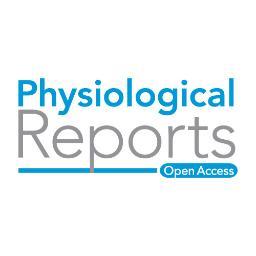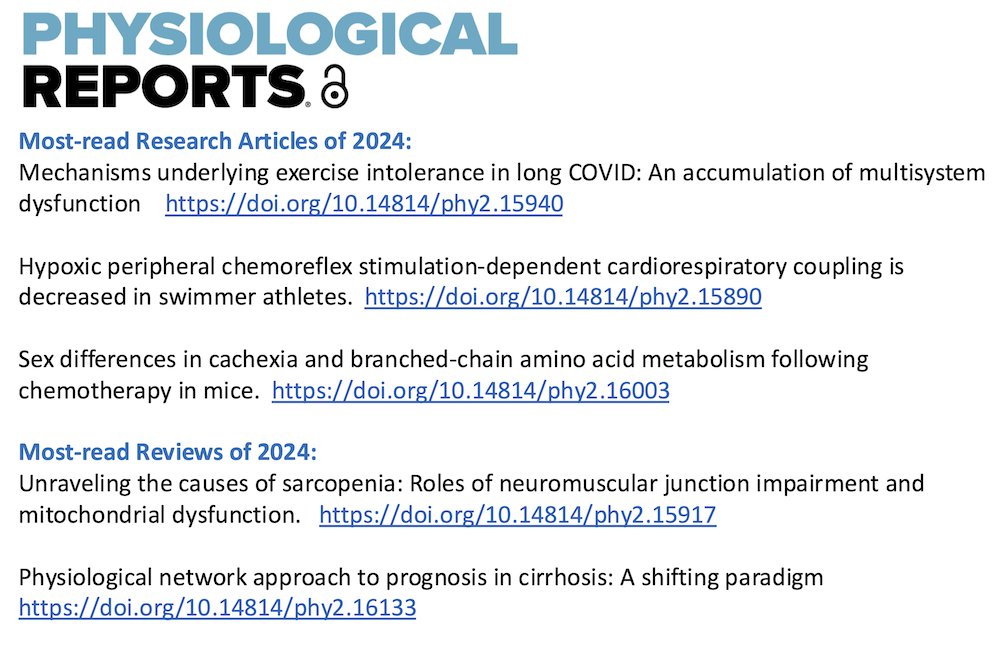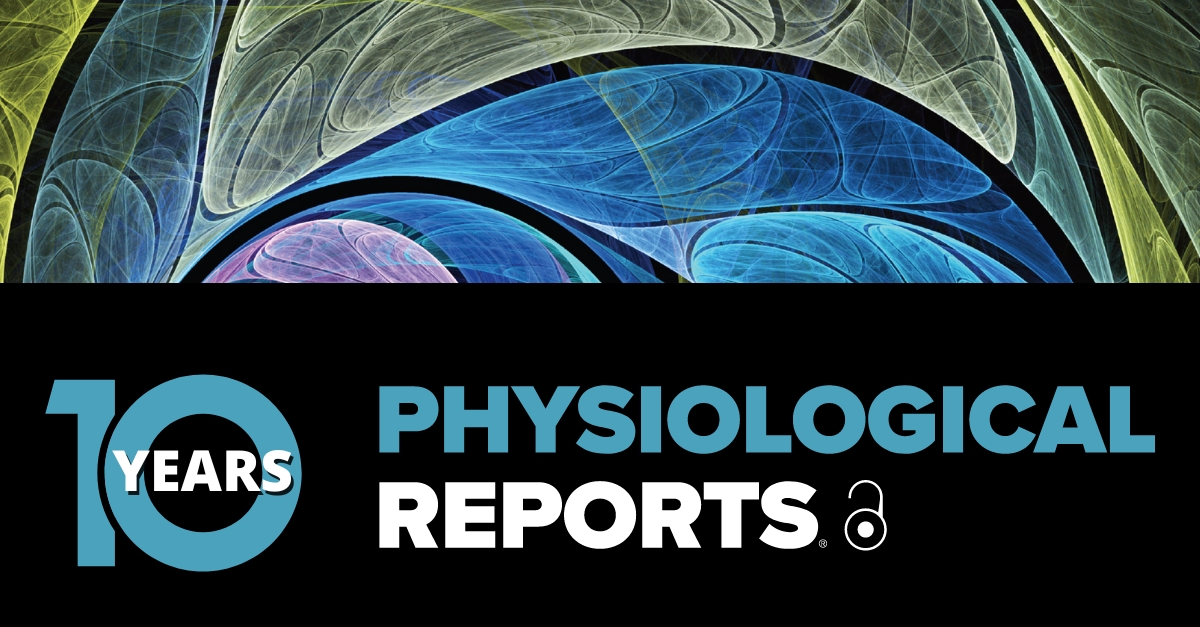
Phys Reports
@PhysRep
Followers
3K
Following
1K
Media
974
Statuses
2K
An online only, open access journal publishing peer-reviewed research across all areas of physiology. A collaboration between The PhySoc and the APS.
Joined March 2013
0
0
2
@PhysRep: #Acetazolamide, an inhibitor of carbonic anhydrase that can induce arteriolar #vasodilation, is shown in this pilot study of acute #braininjury patients to increase brain #oxygenation and #intracranial #pressure. https://t.co/aYbqnMotps
@Hypoxia @CerebralVasculature
physoc.onlinelibrary.wiley.com
Administration of acetazolamide in patients with acute brain injury resulted in a significant increase in brain oxygenation, accompanied by a concurrent rise in ICP and flow velocities, suggesting...
0
0
0
@PhysRep: Hearts of #pyruvatekinase M2 KO mice show increased oxidative stress, #inflammation and #fibrosis after #myocardial #infarction, implicating a protective role of #PKM2. https://t.co/kwK47su59g
@Cardiovascular
physoc.onlinelibrary.wiley.com
Inflammation and a metabolic shift from oxidative metabolism to glycolysis are common in the ischemic heart, the latter partly controlled by pyruvate kinase (muscle, PKM). We previously identified...
0
1
3
@PhysRep: In this new paper, #thoracic load carriage in hypoxic conditions to mimic high #altitude is shown to increase physiological strain and interfere with compensatory responses to #hypoxia in healthy males. https://t.co/pSnb5vKhxG
@Respiratory #MuscleFatigue #Hemodynamics
physoc.onlinelibrary.wiley.com
To assess the impact of thoracic load carriage on the physiological response to exercise in hypoxia. Healthy males (n = 12) completed 3 trials consisting of 45 min walking in the following conditio...
0
0
1
@PhysRep: This new report shows that regulation of miRNA-1, a #skeletal #muscle specific #miR, is necessary for mechanical overload-induced muscle #hypertrophy in a mouse model https://t.co/gTTpjhKH1s
#myotwitter
physoc.onlinelibrary.wiley.com
Schematic representation of mice subjected to mechanical overload (via synergist ablation) following miR-1 overexpression to determine its role in skeletal muscle hypertrophy. Muscle tissue samples...
0
0
1
@PhysRep: Congratulations to all the Authors of our most-read papers of 2024! @ThePhySoc @APSPhysiology @WileyBiomedical
#Physiology
0
0
2
@PhysRep: This comparison of #arterial #stiffness at different body sites in swimmers, cyclists and untrained controls indicates swimmers can develop segment-specific reduction in #heart #brachial arterial stiffness. https://t.co/J2Haslwj9Y
@Exercise @Vascular
physoc.onlinelibrary.wiley.com
Contrary to cardiovascular risk reductions by aerobic exercise, arterial stiffness, as assessed by brachial-ankle pulse wave velocity (PWV), is higher in swimmers and controls than in other aerobic...
0
1
2
@PhysRep: Inter-organ #metabolism in @sepsis: this study in a porcine model of acute sepsis investigates the across-organ net fluxes of #gluconeogenesis substrates and the roles of #adipose and #muscle tissue breakdown https://t.co/pIRMjPMASb
physoc.onlinelibrary.wiley.com
Sepsis leads to an acute breakdown of muscle to support increased caloric and amino acid requirements. Little is known about the role of adipose and muscle tissue breakdown and intestinal metabolism...
0
0
0
@PhysRep: This study on mice deleted for regulator of #Gprotein signaling proteins reports LV dilation and increased #myocardial #immune cells, without additional effect of sustained #βadrenergic receptor signaling https://t.co/vOk2CM5JVU
@Cardiovascular @Heart #CellSignalling
physoc.onlinelibrary.wiley.com
Regulation of Gαi/o by RGS2 and RGS5 of the R4 family of RGS proteins is key to homeostatic control of cardiac structure and function by adenylyl cyclase (AC)-mediated cAMP signaling downstream of...
0
0
0
@PhysRep: New report on #cardiac, autonomic, #haemodynamic and #biomarker responses in trained men taking 2 Olympic distance, lab. based #duathlon, 7 days apart. Functional and biomarker changes were similar to after #triathlon. https://t.co/I9l38aQcmw
@Cardiovascular @Exercise
physoc.onlinelibrary.wiley.com
The effects of triathlon exercise on cardiac function are well documented. While Olympic triathlon (swim-bike-run) remains the standard format, increasing concerns about water quality in natural...
0
0
0
@PhysRep: Studies on female hormonal responses to #exercise are limited. This report shows that a 30-min exercise #stress test leads to hormonal elevations in saliva and plasma of young healthy females. https://t.co/OGmBVtjwbV
#WomensHealth @Physiology @Endocrinology
physoc.onlinelibrary.wiley.com
Overreaching, a consequence of intensified training, is used by athletes to enhance performance. A blunted hormonal response to a 30-min interval exercise stress test (55/80) has been shown in males...
0
0
1
@PhysRep: Studies on female hormonal responses to #exercise are limited. This report shows that a 30-min exercise #stress test leads to hormonal elevations in saliva and plasma of young healthy females. https://t.co/OGmBVtk41t
#WomensHealth @Physiology @Endocrinology
physoc.onlinelibrary.wiley.com
Overreaching, a consequence of intensified training, is used by athletes to enhance performance. A blunted hormonal response to a 30-min interval exercise stress test (55/80) has been shown in males...
0
0
0
@PhysRep: This study sets up a new methodology to induce #Cardiac #alternans like contraction status in vitro in human-induced pluripotent #stemcell derived #cardiomyocytes
https://t.co/bB8SXfBSC2
@Cardiovascular @iPSC @CellPhysiology
physoc.onlinelibrary.wiley.com
Cardiac alternans (C-ALT) is a phenomenon of alternating strong and weak contractions in the heart and is considered a risk factor for the development of heart failure and arrhythmias. However, no...
0
0
2
@PhysRep: The editors thank all authors, reviewers, editors, readers and journal staff for their support of Physiological Reports in 2024. Wishing All in our community Happy Holidays and great research in 2025! @APSPhysiology @ThePhySoc @WileyBiomedical @WileyNeuro #Physiology
0
1
4
@PhysRep: Our Editor’s choice paper from November is "Force monitoring reveals single trial dynamics of motor control in a stop signal task" by Surabhi Ramawat and colleagues. Read the paper at: https://t.co/4iphqjqFIS
#Biomechanics
physoc.onlinelibrary.wiley.com
The Stop Signal Task (SST) has been the benchmark for studying the behavioral and physiological basis of movement generation and inhibition. In our study, we extended the scope beyond physiological...
0
0
1
@PhysRep: Also now posting on BlueSky! @physrep.bsky.social @physoc.bsky.social @ThePhysSoc
@APSPhysiology @WileyBiomedical
0
0
1
@PhysRep: This study examines how #hypercholanemia disturbs #pregnancy-related @adipose tissue expansion and mRNA expression in late gestation in mice, with implications for #intrahepatic #cholestasis of @pregnancy
https://t.co/uNNDjQwWxq
physoc.onlinelibrary.wiley.com
Women with intrahepatic cholestasis of pregnancy (ICP) have hypercholanemia alongside an increased risk of dyslipidemia. We investigated how cholic acid (CA) supplementation in murine pregnancy...
0
0
0
@PhysRep: This study in a porcine model compares unilateral and bilateral @RenalArtery #stenosis conditions to investigate effects on #Renal pressure-flow relationship and #renin activation https://t.co/5lsBUkXr4c
physoc.onlinelibrary.wiley.com
Because renal artery stenosis (RAS) often presents bilateral, we sought to investigate the renal pressure-flow relationship and its relation to renin release, in the presence of a contralateral...
0
0
0
@physrep: New study comparing #physiological responses of healthy adults to computer-based cognitive or #motor-cognitive training shows motor-cognitive SKILLCOURT to be adaptable for a broad range of #exercise intensities. https://t.co/4pBtVPruJD
#Heartrate @Respiratory
physoc.onlinelibrary.wiley.com
Motor-cognitive training and exergaming often only reach low-to-medium intensities that limits their training efficiency. This study evaluated the physiological profile of different exercises on a...
0
0
1
@PhysRep: Our Call for Papers on Women’s Health Research in Basic and Translational @Physiology is now open! Find out more at https://t.co/ceqdz0OtD9
@APSPhysiology @ThePhySoc @physoc.bsky.social @WileyBiomedical
0
2
2
@PhysRep: Study of effects of Fetal #growth #restriction on gene expression during #differentiation of perirenal #preadipocytes implicates target genes that may affect the risk of male FGR for obesity in adulthood. https://t.co/39TcGcPJMf
#epigenetics @developmentalbiology
physoc.onlinelibrary.wiley.com
Fetal growth restriction (FGR) is a risk factor for obesity in adult life. Importantly, growth-restricted females are more prone to obesity than males. The mechanisms involved in this sexually...
0
0
0





